

HOW TO MAKE A VINTAGE BEADED NECKLACE |
|
According to archeological finds, beads have been in existence for over 20,000 years. The earliest samples were made of bone and horn. Beads made of pottery dating back to the 5th through 10th centuries have been excavated in Syria. In Egypt, beads were woven intricately into shawls... and it was beads that adorned the ceremonial apron which Tutankhamen was laid to rest in.
On this page you will see a few of the necklaces I've created using vintage brooches as centerpieces. Almost anything can be used as a centerpiece providing it has a hole at each side or at the top so that it can be threaded for stringing. Open filigree will serve as holes. We've provided much information to help you to begin creating your own wearable art, including a recipe for making dough beads. If you'd like to try your hand at creating a spectacular beaded necklace with a beautiful vintage brooch as the centerpiece, if you would like to own a piece that is one of a kind, if you are looking for a new and rewarding hobby... we have information to get you started: |
 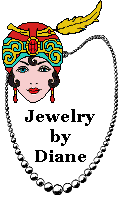 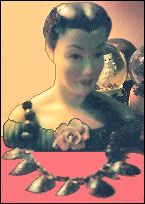 |
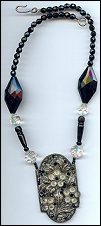    
  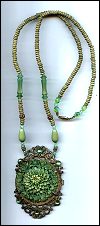  |
| Necklaces 1-5 were made with vintage brooches. Necklace 6 was made with an Art Nouveau face found at a street fair for 50 cents. 7 is an old shoe clasp, 8 was made with a carved green antique celluloid belt buckle, and 9 with an orange celluloid leaf pendant. |
|
If you think you'd like to try your hand at creating a spectacular beaded necklace with a beautiful antique brooch as the centerpiece...
If you think you would like to own a piece that is truly one of a kind ... If you are looking for a new and rewarding hobby... then here is some information to get you started: |
|
HOW TO THREAD YOUR BROOCH
|
|
THE HUNT FOR BEADS, BROOCHES AND SUPPLIES Ebay is the best place to purchase beads, antique brooches, and large lots of inexpensive vintage necklaces whose beads and clasps you can use to create many pieces. There are often lots of old "for repair" necklaces. Search for "lots vintage necklaces". Ebay lists everything you will need to get started from beads and stringing materials, to tiny bead spacers and clasps and jewelry-making books. Another place online to buy everything you will ever need at great prices is Fire Mountain Gems. Send for their free big fat catalog. It's a treasure. Don't overlook antique stores, thrift shops and garage sales. Let friends and relatives know what you are looking for. They just may clean out their jewelry boxes for you. Some of the older necklaces have beads that are unique and beautiful. Many a time they are not in perfect condition and can be purchased at good prices. Save all of the old clasps you come across for re-use. |
THE BEADS
 | There are many types of beads available. The chart shows some of the more popular ones. Your necklaces can be made with mixed types of beads. For instance, Turquoise and Lapis Lazuli look wonderful together, and Crystal mixes beautifully with any type of bead. We've included below an interesting list on the characteristics of gemstones and the facts and folklore surrounding them. The instructions will continue after the list. |
 DID YOU KNOW THAT... DID YOU KNOW THAT... |
| AMBER is the lightest of all gem stones. It is so light that it will float in salt water. Colors range from dark brown to a light almost clear lemon yellow. True amber began as sticky resin which oozed from ancient pine trees. Over time, small insects and plant material in the path of the flow became entrapped. As time went by, the resin was encased in the ground and through a process of heat and pressure it fossilized to become amber. The value of a piece of Amber depends on the rarity and condition of the object trapped inside it. Complete insect specimens are very rare and costly. To test if your amber beads or nuggets are authentic or man-made make a saturated solution of table salt and water and place them in the mixture. If they float, they are amber. If they sink, they are man-made. Man-made is not necessarily a bad thing. There are some beautiful pieces on the market. Legend has it that Amber was believed to provide magicians and sorcerers with special enhanced powers. |
| AMETHYST belongs to the quartz family. It is found in Brazil, Zambia, Uruguay, Russia, Sri Lanka, Mexico, and Arizona. Amethyst varies in color from lavender to deep purple. The deeper colors are more prized than the paler lavender shades. Throughout time amethyst has been believed to guard against drunkenness and is thought to be helpful in overcoming addiction. It has been used for hearing disorders, insomnia, headaches and general pain. |
|
AUSTRIAN CRYSTAL was invented by an English glass-maker named George Ravenscroft in the late 1600's using a mixture of white glass, silica, lime and lead oxide. Chemicals were added to create the different colors. There is something magical about the sparkle and shine of crystal beads that sets them apart from other types of faceted beads. These beads are sometimes known as leaded glass or Aurora Borealis beads. While there are many manufacturers, Swarovski is the leader in the field. Their crystal beads have a high content of lead which imparts an incredible sparkle and clarity. Although there are no official American standards regarding crystal, the offiical British Standard (BS 3828:1973) states that:
...................... Fine crystal must contain 6% to 10% lead oxide ...................... Lead crystal must contain 10% to 24% lead oxide ...................... Full lead crystal must contain 24% or more lead oxide Using Crystal beads intermittently as spacers in a necklace or bracelet will make for a spectacular, eye-catching piece of jewelry. Crystal is especially gorgeous when paired with Millefiori beads. The important thing when purchasing crystal beads is quality. Spend a bit more. You won't need many to use them as spacers. |
| CARNELIAN is a member of the quartz family and is sometimes known as red agate. It is mined in Australia, Brazil, Madagascar, India, Russia, Africa and the United States. Carnelian varies in color from shades of orange to reddish brown. The Egyptians believed that Carnelian had special powers in the afterlife having to do with the passage of the soul into the next world. For this reason large amounts of Carnelian jewelry have been found in ancient Egyptian tombs. It was also believed that this gemstone cleansed the blood and provided protection against evil spirits. |
| CITRINE is believed to inspire warmth, prosperity and ease. The name "Citrine" comes from an old French word, Citrin, meaning yellow. The Citrine gem stone is a quartz crystal which varies in color from pale yellow to deep amber. According to legend Citrine protects against snake venom and evil thoughts. |
| CORAL is found in still, clear water between 25 and 1000 feet deep. It grows in branches and is mostly found in the Mediterranean Sea or in the Pacific. Coral beads and artifacts were found in the graves of pre-dynastic Egypt, from as far back as 4000 B.C., as well as in graves from the Iron Age, and in Neolithic sepulchers dating back to 10,000 B.C. Throughout the world, museums have coral collections of amulets and ornaments going as far back as 1000 B.C. Coral was thought to quiet the waves and made the sea calm. The Romans believed coral to be a potent charm, and hung branches of coral around the necks of their children to preserve them from harm. |
| JADE is a symbol of love and virtue. Ancient cultures believed that wearing jade would increase body strength and offer longevity. The colors in this mineral range from pastel greens to the deeper and darker greens. Imperial Jade is the most valuable form of Jade. It comes from Burma and it is an emerald green color. |
| GARNET jewelry been found as early as the Bronze Age (3000 BC) in burial sites. The gemstone is formed in rock with the aid of high temperatures. Early communities valued garnet highly and believed that it offered protection in the after life. In ancient times garnets were exchanged between friends in the belief that this would allow them to cross paths again in the afterlife. Garnets are available in many colors. Pyrope is the name of the dark red color of this stone that most people are familiar with. |
| LAPIS LAZULI was mined as far back as 6,000 years ago in Afghanistan. The gemstone is a vivid shade of blue with white veins and a sometimes faint scattering of gold sparkles. The Egyptians used ground up Lapis for cosmetic purposes, as paint, and also carved it into vases and figurines. It is said that this gemstone promotes awareness and ESP. The best quality comes from Afghanistan but it is also found in Pakistan, Siberia, Chile, the U.S. and Canada. |
| MILLEFIORI is an Italian word meaning "a thousand flowers". Millefiore beads are also referred to as Mosaic or Trade Beads. Some have been around since the late 1800's. These beads have intricate designs and brilliant colors and can be found in many shapes and sizes. |
| PERIDOT has been mined as a gemstone for thousands of years. It is mentioned in the Bible under the name Chrysolite. It was used by the Egyptians as early as 1500 BC and was considered the gem of the sun. It is believed that peridot was Cleopatra's favorite gemstone. Peridot ranges in color from light yellow-green to intense bright green. It is rumored that miners searched for peridot crystals at night because the moonlight made the crystals easier to see. They would mark the location and come back in the daylight to dig them up. The mineral is said to bring the wearer success and good fortune. |
| ROSE QUARTZ is probably one of the most prized stones for it mystical properties. The word, quartz, comes from the Greek word, krustallos, which means ice. Throughout history, Rose Quartz has been a symbol of love and beauty. These Semi precious beads have been used as both ornament and as currency. |
| TIGER'S EYE is a member of the quartz family. It is mined in Western Australia, South Africa, USA, Canada, India, Namibia, and Burma. The rippled wavy bands of color often make for an intricate pattern. Due to the fibrous structure of the material light is reflected within the thin parallel bands. It is believed that wearing tiger's eye aids health and spiritual well being. |
|
TURQUOISE was used by the Egyptians thousands of years ago. It can be found in a range of colors that vary from green to aqua to light blue. For centuries the most valuable turquoise came from Iran. A large amount of turquoise comes from Arizona, California, New Mexico and Nevada. Ancient cultures believed that Turquoise brought good luck in the areas of money and love. |
NECKLACE LENGTH CHART
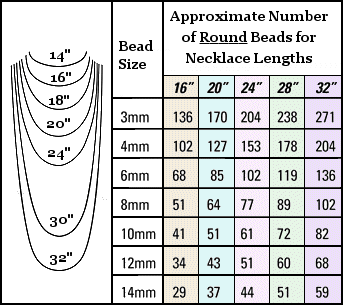 | The chart will give you an estimate of how many beads are needed for different size necklaces. However, when you mix beads each will be a different size. The chart is for beads that are all the same size...but we've included it to give you a rough idea. Also, when you use a brooch you will need fewer beads. If you find that you don't have enough beads in the middle of a project use seed beads between the beads as spacers. Keep them on hand in all colors. They come in small vials or packs and are inexpensive. |
USING A BEAD BOARD
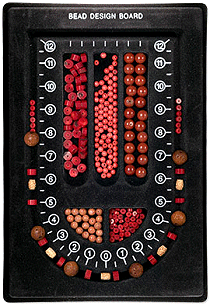 | Bead boards are ideal to work on and save time. You won't commit to stringing until the pattern is the way you want it. For an 18" necklace center your brooch over the zero and add beads on both sides until you reach number 9 (9+9=18"). Once you are happy with your design, the beads can be strung. Remember that the clasp will add anywhere from 1/4" to 1/2" depending on its size. If the necklace is long enough to slip over your head you won't need a clasp. There are many ways to add a clasp. A good instruction book is "Complete Beading for Beginners" by Karen Rempel. The multiple compartments in the board are for storing your beads so that you have them right in front of you. Beads love to roll so if you choose to work without a bead board put all beads in bowls so they don't roll onto the floor. If there are pets around do not leave your work unattended. Beads and stringing material pose a great danger to them. |
STORING THE BEADS
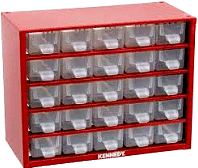 | Once you are hooked on collecting beads you'll want to store them in a way that will allow you to quickly select what you need. For this purpose you can purchase at a lumber yard or hardware store several of the little bins that each have many see-through drawers. Buy several and stack them on a closet shelf. The larger ones have 60 drawers and are only about 15" x 15" x 7" deep. These bins were made to hold nails and screws but they are great for storing beads. Separate beads by color. Another option for storing beads is to use small glass jars. Baby food jars are great to store small beads, and spice bottles work well for tiny seed beads. |
 HERE IT IS: THE RECIPE FOR DOUGH BEADS HERE IT IS: THE RECIPE FOR DOUGH BEADS
2 cups of flour 1 cup of salt 1 cup of water Mix all ingredients together and knead on a flour covered board for a few minutes. Form into beads. Thread beads on metal skewers or tooth picks to punch and maintain hole while baking, taking care not to let one bead touch the next. Bake in a 250 degree oven for 1-1/2 hours. Let cool. Paint with poster paint or enamel. When dry, add clear acrylic varnish or nail polish to seal and impart a shiny finish. It is my hope that this page will inspire many fun filled hours of creative discovery. |
 ... ... Meet Red-Devil ..................... Meet Dracula |
